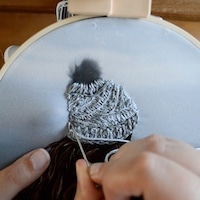
Photo: AndrewLozovyi/Depositphotos
Hair loss is a problem more common than you may realize. About 85% of men and 33% of women will suffer from hair loss at some point. That's what makes a new breakthrough so exciting. While transplants and drugs like Rogaine and Propecia have long helped, UCLA scientists have discovered something that might be even more efficient—PP405.
This small molecule appears to have a big impact on hair, able to awaken dormant but undamaged follicles. Lab work on the molecule has been ongoing for a decade, with scientists isolating PP405 and applying it to a protein in follicle stem cells that keeps them dormant. The molecule inhibits this protein, which then awakens the stem cells. The first human trials took place in 2023 and produced promising results after a topical medicine was applied to the scalp at bedtime for a week.
“No such product will work for everyone,” says Dr. William Lowry, associate director of the UCLA Broad Stem Cell Research Center, “but our first human trials in Orange County have been very encouraging, and there are larger trials with more people to follow.”
Most excitingly, the team believes the treatment will produce full “terminal” hair rather than the peach fuzz that topical treatments are known for. While waiting for FDA approval, the scientists co-founded a medical development company called Pelage Pharmaceuticals. Backed by Google Ventures, the company raised $16.4 million last year for further trials. If all goes well, hair treatments using PP405 should hit the market between 2027 and 2030.
Source: Did UCLA Just Cure Baldness?; Molecule PP405: A Research Team Backed By Google Ventures Has Discovered One Of The Most Promising Solutions For Hair Loss To Date
Related Articles:
Researchers Develop mRNA Treatment That Could Combat a Peanut Allergy
Paralyzed Man Is Able To Stand on His Own Again Thanks to Breakthrough Stem Cell Trials
Breakthrough Ultrasound Therapy Cures Man Who Had Tremors in His Hand for Over 30 Years
Scientists Develop Antiviral Chewing Gum Fighting Up to 95% of Flu and Herpes Virus Transmission






















































































